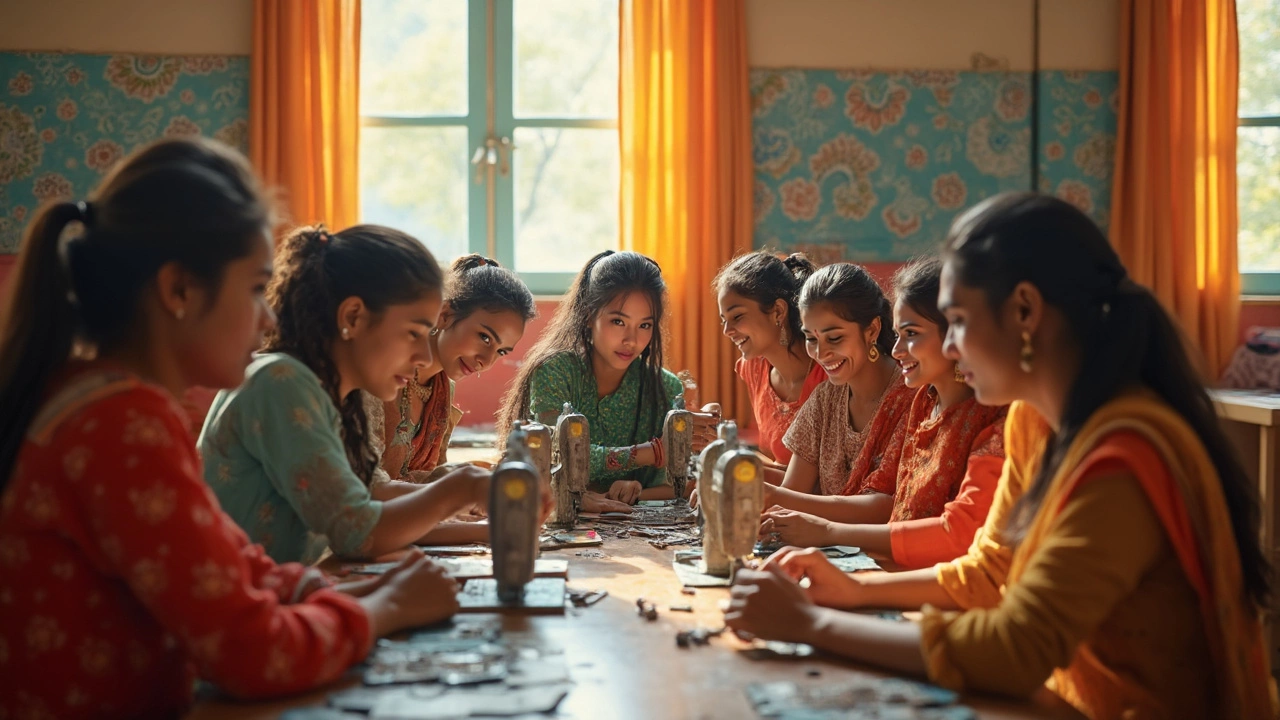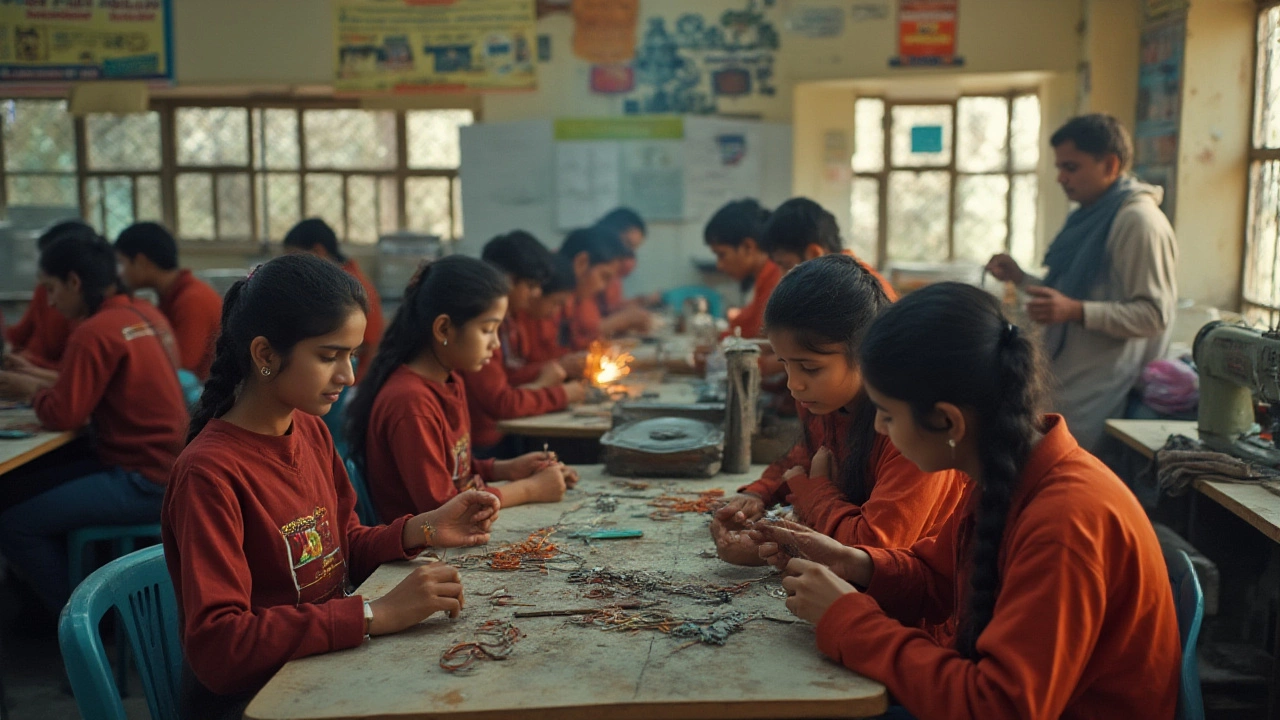Most people think vocational training is just classroom stuff, but that's not even half the story. For women looking to boost their skills or start something new, vocational training usually means digging into real activities that make a difference.
You'll see a ton of hands-on sessions where you actually do the work, not just listen about it. Whether it’s tailoring, beauty care, baking, or computer work, you get your own tools and learn by doing. These are not just theory lessons but skills you use at home or for a job.
Plus, a lot of programs now mix in basic business classes—how to talk to customers, manage accounts, or even run your own small shop. It’s way more practical than any boring textbook stuff. Many centers bring in women who've already nailed these fields to share what really works and what doesn't.
If you're wondering whether it's easy to jump in, the best thing is most programs start from scratch. No fancy degrees needed. You'll find a group of women from all sorts of backgrounds, learning together, supporting each other, making mistakes, and improving fast. That peer support is honestly half the magic.
- Why Vocational Training Matters for Women
- Types of Skills Covered
- Hands-On Workshops and Practice
- Business and Soft Skills Training
- Real-World Projects and Field Experience
- How to Choose the Right Program
Why Vocational Training Matters for Women
When it comes to any kind of job or running your own gig, it’s not just about having a degree. The real game-changer for many women is vocational training. It opens doors that might have been shut before, especially for those who didn’t get the chance to finish school or college.
Here’s something you might not know: According to a 2024 government skill development report, about 56% of women who went through vocational training in India landed a job or started their own business within one year. That’s a huge bump compared to those without any training—less than 30% managed to get work.
| With Vocational Training | Without Vocational Training |
|---|---|
| 56% got employed/self-employed | 29% got employed/self-employed |
It’s not just about income, either. Skills training helps women gain real confidence, make their own choices, and stand on their own feet. Many who join these programs often say things like, "I never thought I could do this." Seeing that they can actually fix a bike, use a computer, do tailoring, or manage a small store changes how they see their future.
Vocational courses are practical and short-term. Instead of spending years in school, women pick up skills in just a few months. This is massive for those who have to manage family, kids, or even farm work. Here are a few key reasons why these programs make a huge difference:
- They give women the skills to earn money at home or outside.
- Flexible schedules mean women can balance home and learning.
- A ton of courses lead to in-demand jobs, like healthcare, beauty, computers, and food services.
- Real mentors and trainers support every step—no one gets left behind.
The ripple effect is real. When one woman upskills, her whole family often benefits. Kids do better in school, families get healthier meals, and there’s less pressure on just one earning member. That’s why you see more and more women signing up every year, changing communities one skill at a time.
Types of Skills Covered
When you hear about vocational training for women, expect more than just one or two random lessons. Programs are usually packed with practical skills that match what’s actually needed in jobs or home-based businesses. Here's a quick look at the common types you’ll find:
- Technical Skills: From cutting and stitching in tailoring to mixing chemicals in beauty therapy, you get proper hands-on training. For women interested in tech, basics like MS Office, data entry, and even coding are making their way into courses now.
- Home-Based Skills: Cooking, baking, candle making, and even handmade jewelry are hot favorites. These are not just hobbies anymore—you can earn straight from your living room if you want.
- Trade & Service Skills: Some centers offer electrician basics, mobile repairing, and plumbing for those who want to break stereotypes. More women in smaller towns are picking these up every year.
- Healthcare and Childcare: Short programs train women as nursing assistants, caregivers, and preschool aides. These are super practical because local clinics and private homes are always looking for skilled help.
- Business & Communication: Basic spoken English, digital marketing, and how to manage a shop or boutique make a big difference. Building this confidence is huge for women starting new ventures or freelancing.
Check out some actual numbers from recent reports on what women are choosing the most:
| Skill Area | Percentage of Trainees (2023) |
|---|---|
| Tailoring & Fashion | 29% |
| Computer & Digital Skills | 23% |
| Beauty & Wellness | 19% |
| Baking & Cooking | 14% |
| Trade Skills (Electrician, etc.) | 7% |
| Others | 8% |
So, whether you want something creative or technical—or just want to boost your earning at home—there’s definitely a skill out there that matches what you need.
Hands-On Workshops and Practice
The best part about most vocational training for women is that you don’t just sit and listen—you roll up your sleeves and actually try things out. Almost every program puts a huge focus on hands-on workshops. That means you get real tools, real materials, and you practice the skills until they feel natural.
Say you’re learning tailoring. You’ll spend hours measuring, cutting, using sewing machines, and finally stitching clothes—sometimes for actual customers. In computer courses, you’re at the keyboard from day one, making documents, designing flyers, or learning how to create invoices with real software. Beauty care courses let you work with real makeup, try facial treatments, even cut and style hair—all on live models, not just mannequins.
Many places use step-by-step guidance, so you watch a trainer demonstrate, then you do it yourself. Don’t worry about failing. Mistakes are normal, and the teachers expect them. They’re right there to correct your grip, show you tricks, and explain why something didn’t work. This active learning is proven to make people remember new skills faster and keep them for the long haul. That’s a fact shown in studies from vocational training centers in India and Southeast Asia.
It gets even better when you learn in small groups. You can team up with others, help each other, and see lots of different ways to solve a problem. Whether it’s putting icing on cakes, fixing motors, or making jewelry, you figure things out together. This social side is huge for women, especially those who might not have had much support before.
- Every workshop uses real-world tools and materials
- Trainers show, you try, and practice is repeated until you get it right
- Feedback is instant—mistakes are part of the deal
- Skills are linked straight to real jobs or small businesses
The main goal? You’re confident using a skill in the real world because you’ve done it so many times in practice. That’s why vocational training makes a real difference—it’s not about memorizing, it’s about mastering skills with your own hands.

Business and Soft Skills Training
Here’s something most people miss: Technical know-how gets your foot in the door, but business smarts and people skills keep you there. Every good vocational training program builds in sessions on how to manage money, talk to customers, and handle teamwork. This stuff makes a huge difference when women either start their own business or join a workplace for the first time.
Let’s break down what this usually looks like:
- Communication skills: Simple things like making introductions, explaining your service clearly, or handling tricky customer questions. A lot of women say this part makes them feel way more confident—not just at work, but in everyday life.
- Personal finance basics: Learning how to make a budget, save money, and keep track of expenses. This is key whether you want to grow your own business or just manage salary money better.
- Teamwork and problem-solving: Activities where groups find solutions together, usually through role-play or case studies. It helps with real work challenges and builds trust.
- Customer service: How to be polite, handle complaints, and create a good experience so people keep coming back to your shop or service.
- Digital basics: More programs now teach how to use WhatsApp for business, make simple posters on your phone, or keep customer lists online—useful, right?
Here’s a quick look at the business and soft skills most often taught in Indian vocational training centers for women, based on 2024 surveys:
| Skill Area | Percent of Centers Covering |
|---|---|
| Communication/Soft Skills | 87% |
| Basic Bookkeeping | 68% |
| Customer Service | 72% |
| Digital Literacy | 63% |
Here’s something else a lot of women mention: Practicing these soft skills in a group feels less scary, and instructors usually encourage lots of real-life roleplays. If you’re shy about presenting or talking to new people, you’ll get plenty of safe practice here. Trying, messing up, and trying again—it’s all part of the process.
And if you want to start your own thing, this part of vocational training is gold: You get concrete tips on how to attract and keep customers, set fair prices, and talk with suppliers. No business jargon required—just everyday advice that works in real life.
Real-World Projects and Field Experience
There’s a huge difference between hearing about a skill and actually putting it to use. That’s why most good vocational training programs for women drop you right into real-life projects early on. If it’s a tailoring course, for example, you might spend a week or two just learning basics, but then you’ll get real customer uniforms or dresses to design and stitch. Same goes for courses like beauty and wellness, where trainees often get to practice on real clients under the instructor’s watchful eye. This stuff feels more like a job trial than class homework.
Internships and fieldwork are also common. In India, about 40% of leading vocational centers send trainees for short stints at local small businesses, salons, or workshops, which leads to faster job offers after the course. These placements might last from two weeks up to two months, depending on the program and the industry.
Here’s what trainees typically do during this phase:
- Work on actual products or services for real customers
- Shadow professionals to understand day-to-day work and customer interactions
- Learn problem-solving on the fly—because, let’s face it, things rarely go as planned out in the real world
- Get feedback directly from clients, not just trainers
Many centers make these projects a regular thing, not just a final exam. Some run pop-up shops, mini-cafes, or in-house service counters every few weeks. Here’s a quick snapshot of what different field experiences look like, based on 2024 program data:
| Training Area | Common Field Experience | Avg. Duration (weeks) |
|---|---|---|
| Tailoring | Work in tailor shops, make uniforms for NGOs | 3 |
| Beauty & Wellness | Practice on live clients in salons | 2 |
| Cooking & Baking | Intern in bakeries, run a food stall | 4 |
| Computer Skills | Data entry projects at local offices | 2 |
One tip: Don’t be shy about asking your trainers for extra project work or chances to intern. More exposure means way more confidence and often a better shot at lining up freelance gigs or jobs afterward. This is hands-down where skills start feeling real and useful—where you go from just learning to actually doing.
How to Choose the Right Program
Picking a vocational training course shouldn't feel like a shot in the dark. The first step is figuring out what skill sets are actually in demand. According to a 2024 report by NSDC (National Skill Development Corporation), tailoring, beauty and wellness, healthcare, information technology, and food processing are top skill areas with steady job openings for women.
Here’s a simple way to narrow down your options:
- Goal check: Do you want a job, start a business, or pick up a skill for freelancing? The answer guides your search.
- Trainer credibility: Ask if the trainers have real-life experience. People who’ve actually worked in the field give way better advice than those who’ve just read about it.
- Learning style: Some programs are completely hands-on, others are more classroom-based, and some mix both. Go for hands-on if you want quicker results.
- Support after training: Does the center help with placements or internships? The best programs usually do. Ask for proof—like tallies of how many trainees got jobs last year.
- Length and time flexibility: Check if they have short courses (3-6 months), because most women can’t afford to step out for a whole year.
Many centers claim to offer the best, but only a few keep up with changing trends. If you can, visit the center: look at their tools and classrooms, watch an actual session, and chat with current trainees.
| Factor | Why It Matters |
|---|---|
| Placement Rate | Shows if trainees find jobs after finishing |
| Trainer Experience | Makes a huge difference in what you learn |
| Certification | Some jobs require certificates from recognized centers |
| Practical Exposure | Boosts confidence and actual job skills |
| Fee Structure | Transparent fees help you plan your budget |
If you’re unsure, talk to a few women who have finished the course and ask them what changed for them. Quick hint: real stories beat fancy brochures every time.


